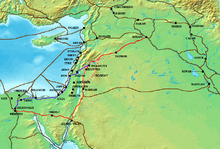Via Maris


Via Maris este numele modern a unui vechi drum comercial, datând de la începutul epocii Bronzului, care leagă Egiptul cu imperiile nordice din Siria, Anatolia și Mesopotamia — astăzi Iran, Irak, Israel, Turcia și Siria. În latină, Via Maris înseamnă "drumul mării." Este un drum istoric care merge de-a lungul coastei mediteraneene a Israelului. Acesta a fost cel mai important traseu dintre Egipt și Siria (Semiluna Fertilă), care trecea pe câmpia de coastă înainte de a intra în Câmpia Izreel și Valea Iordanului.
Numele său anterior a fost "Drumul Filistinilor", o referire la trecerea prin Câmpia Filistină (care astăzi este formată din câmpia de coastă sudică a Israelului și fâșia Gaza). Numele de "Via Maris" nu este vechi, cercetătorii academic preferând alte nume, de exemplu "Șoseaua Principală internațională".[1]
Nume și controverse
[modificare | modificare sursă]Potrivit lui Anson Rainey (1981),[2] "Via Maris" nu este un nume istoric. Expresia provine mai degrabă dintr-o traducere latină din Isaia 9:1 – "aproape de mare".[3] Profetul, probabil, se referea la drumul de la Dan la mare, la Tir, care trece prin Abel-beth-maachah[4], care marca granița de nord a Israelului în momentul cuceririi asiriene.
Referințe
[modificare | modificare sursă]- ^ Northern Exposure: Launching Excavations at Tell Abil el-Qameḥ (Abel Beth Maacah), p. 32, in Strata: Bulletin of the Anglo-Israel Archaeolocial Society, 2013, Volume 31
- ^ Anson Rainey, "Toponomic Problems (cont.)" in Tel Aviv 8 (1981), cited after Stephen Langfur, The "Via Maris" (netours.com) Arhivat în , la Wayback Machine., c.f. also Anson F. Rainey and R. Steven Notley's Carta's New Century Handbook and Atlas of the Bible(2007), p. 76: "The coastal trunk route (popularly and wrongly called Via Maris),..."
- ^ Isaiah 9:1/Hebrew Bible Isaiah 8:23: "In the past he humbled the land of Zebulun and the land of Naphtali, but in the future he will honor Galilee of the Gentiles, by the way of the sea, along the Jordan." The Vulgate (the Christian Bible, both the Old and New Testament in Latin translation), Matthew 4:15 reads: "terra Zabulon et terra Nephthalim via maris trans Iordanen Galilaeae gentium" – "The land of Zebulun and the land of Naphtali, by the way of the sea, beyond the Jordan, Galilee of the Gentiles." (NKJV translation)
- ^ Nava Panitz-Cohen et al., Northern Exposure: Launching Excavations at Tell Abil el-Qameḥ (Abel Beth Maacah), p 32 in Strata: Bulletin of the Anglo-Israel Archaeolocial Society, 2013, Volume 31
| |||||||
Text is available under the CC BY-SA 4.0 license; additional terms may apply.
Images, videos and audio are available under their respective licenses.

